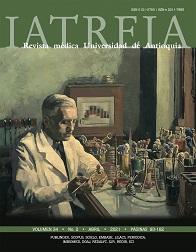Tomografía abdominal sin contraste oral: evaluación de su rendimiento en el dolor abdominal agudo no traumático
DOI:
https://doi.org/10.17533/udea.iatreia.78Palabras clave:
abdomen agudo, dolor abdominal, medios de contraste, tomografía computarizadaResumen
Objetivo: evaluar el rendimiento diagnóstico de la tomografía abdominal sin medio de contraste oral en pacientes con dolor abdominal.
Materiales y métodos: se incluyeron tomografías de pacientes con dolor abdominal entre el 1 de septiembre y 31 de diciembre del 2015 en el Hospital Universitario San Vicente Fundación. Se analizó el desempeño de las tomografías con o sin contraste oral y se consideró como prueba de referencia el resultado diagnóstico definitivo en la intervención quirúrgica o por diagnóstico clínico. Se calculó la sensibilidad, especificidad y los valores predictivos positivos y negativos con intervalos de confianza del 95%.
Resultados: fueron evaluadas un total de 128 tomografías de abdomen, 91 con contraste oral y 37 sin él. La tomografía sin contraste oral tuvo una sensibilidad y especificidad muy similar a la que sí lo tenía, con valores de 84% y 91,6%, respectivamente.
Conclusión: el rendimiento global de la tomografía con contraste oral fue similar a la que no lo tenía, con valores cercanos al 90%. La adquisición de la tomografía con contraste oral tomó casi 3 veces más tiempo que el requerido en los estudios sin contraste oral.
Descargas
Citas
(1) Gore R, Levine M. Textbook of Gastrointestinal Radiology. 4. ed. Philadelphia: Saunders Co; 2015.
(2) Ros PR, Mortele KJ. CT & MRI of the Abdomen and Pelvis: A Teaching File. 3. ed. Philadelphia: LWW; 2013.
(3) Anderson SW, Menias C, Soto JA. Gastrointestinal Imaging Cases. New York: McGraw-Hill Education; 2013.
(4) Soto JA, Lucey BC. Emergency radiology: the requisites. 2. ed. Philadelphia: Elsevier; 2016.
(5) Hamlin D, Burgener F. Positive and negative contrast agents in CT evaluation of the abdomen and pelvis. J Comput Tomogr. 1981;5(2):82-90. DOI 10.1016/0149-936X(81)90020-5.
(6) Garrett P, Meshkov S, Perlmutter G. Oral contrast agents in CT of the abdomen. Radiology. 1984;153(2):545-6. DOI 148/radiology.153.2.6484186.
(7) Lee JKT, Sagel SS, Stanley RJ. Computed Body Tomography with MRI Correlation. 4. ed. North Carolina: Wolters Kluwer Health; 2006.
(8) Stuhlfaut J, Soto J, Lucey B, Ulrich A, Rathlev N, Burke P, et al. Blunt Abdominal Trauma: Performance of CT without Oral Contrast Material. Radiology. 2004;233:689-94. DOI 10.1148/radiol.2333031972.
(9) Lee C, Haaland B, Earnest A, Tan C. Use of positive oral contrast agents in abdominopelvic computed tomography for blunt abdominal injury: meta-analysis and systematic review. Eur Radiol. 2013;23(9):2513-21. DOI 10.1007/s00330-013-2860-8.
(10) Harieaswar S, Rajesh A, Griffin Y, Tyagi R, Morgan B. Routine Use of Positive Oral Contrast Material Is Not Required for Oncology Patients Undergoing Followup Multidetector CT. Radiology. 2009;250(1):246-53. DOI 10.1148/radiol.2493080353.
(11) Levenson R, Camacho M, Horn E, Saghir A, McGillicuddy D, Sanchez L. Eliminating routine oral contrast use for CT in the emergency department: impact on patient throughput and diagnosis. Emerg Radiol. 2012;19:513-7. DOI 10.1007/s10140-012-1059-7.
(12) Razavi S, Johnson J, Kassin M, Applegate K. The impact of introducing a no oral contrast abdominopelvic CT examination (NOCAPE) pathway on radiology turnaround times, emergency department length of stay, and patient safety. Emerg Radiol. 2014;21:605-13. DOI 10.1007/s10140-014-1240-2.
(13) Schuur J, Chu G, Sucov A. Effect of oral contrast for abdominal computed tomography on emergency department length of stay. Emerg Radiol. 2010;17:267-3. DOI 10.1007/s10140-009-0847-1.
(14) Hill B, Johnson S, Owens E, Gerber J, Senagore A. CT Scan for Suspected Acute Abdominal Process: Impact of Combinations of IV, Oral, and Rectal Contrast. World J Surg. 2010;34:699-703. DOI 10.1007/s00268-009-0379-6.
(15) Uyeda J, Yu H, Ramalingam V, Devalapalli A, Soto J, Anderson S. Evaluation of Acute Abdominal Pain in the Emergency Setting Using Computed Tomography Without Oral Contrast in Patients With Body Mass Index Greater Than 25. J Comput Assist Tomogr. 2015;39(5):681-6. DOI 10.1097/RCT.0000000000000277.
(16) Alabousi A, Patlas M, Sne N, Katz D. Is Oral Contrast Necessary for Multidetector Computed Tomography Imaging of Patients With Acute Abdominal Pain? Can Assoc Radiol J. 2015;66:318-22. DOI 10.1016/j.carj.2015.03.003.
(17) Anderson B, Salem L, Flum D. A systematic review of whether oral contrast is necessary for the computed tomography diagnosis of appendicitis in adults. Am J Surg. 2005;190(3):474-8. DOI 10.1016/j.amjsurg.2005.03.037.
(18) Anderson S, Soto J, Lucey B, Ozonoff A, Jordan J, Ratevosian J, et al. Abdominal 64-MDCT for Suspected Appendicitis: The Use of Oral and IV Contrast Material Versus IV Contrast Material Only. AJR Am J Roentgenol. 2009;193(5):1282-8. DOI 10.2214/AJR.09.2336.
(19) Kepner A, Bacasnot J, Stahlman B. Intravenous contrast alone vs intravenous and oral contrast computed tomography for the diagnosis of appendicitis in adult ED patients. Am J Emerg Med. 2012;30(9):1765-73. DOI 10.1016/j.ajem.2012.02.011.
(20) Laituri C, Frasier J, Aguayo P, Fike F, Garey C, Sharp S, et al. The Lack Of Efficacy For Oral Contrast In The Diagnosis Of Appendicitis By Computed Tomography. J Surg Res. 2011;165(2):193-4. DOI 10.1016/j.jss.2010.11.605.
(21) Rosen M, Sands D, Longmaid H, Reynolds K, Wagner M, Raptopoulos V. Impact of Abdominal CT on the Management of Patients Presenting to the Emergency Department with Acute Abdominal Pain. AJR Am J Roentgenol. 2000;174(5):1391-6. DOI 10.2214/ajr.174.5.1741391.
(22) Huynh L, Coughlin B, Wolfe J, Blank F, Lee S, Smithline H. Patient encounter time intervals in the evaluation of emergency department patients requiring abdominopelvic CT: oral contrast versus no contrast. Emerg Radiol. 2003;10:310-3. DOI 10.1007/s10140-004-0348-1.
(23) Platon A, Jlassi H, Rutschmann O, Becker C, Verdun F, et al. Evaluation of a low-dose CT protocol with oral contrast for assessment of acute appendicitis. Eur Radiol. 2008;19:446-54. DOI 10.1007/s00330-008-1164-x.
(24) Buttigieg E, Grima K, Cortis K, Soler S, Zarb F. An evaluation of the use of oral contrast media in abdominopelvic CT. Eur Radiol. 2014;24(11):2936-44. DOI 10.1007/s00330-014-3285-8.
Publicado
Cómo citar
Número
Sección
Licencia
Derechos de autor 2021 Universidad de Antioquia

Esta obra está bajo una licencia internacional Creative Commons Atribución-NoComercial-CompartirIgual 4.0.
Los artículos publicados en la revista están disponibles para ser utilizados bajo la licencia Creative Commons, específicamente son de Reconocimiento-NoComercial-CompartirIgual 4.0 Internacional.
Los trabajos enviados deben ser inéditos y suministrados exclusivamente a la Revista; se exige al autor que envía sus contribuciones presentar los formatos: presentación de artículo y responsabilidad de autoría completamente diligenciados.














